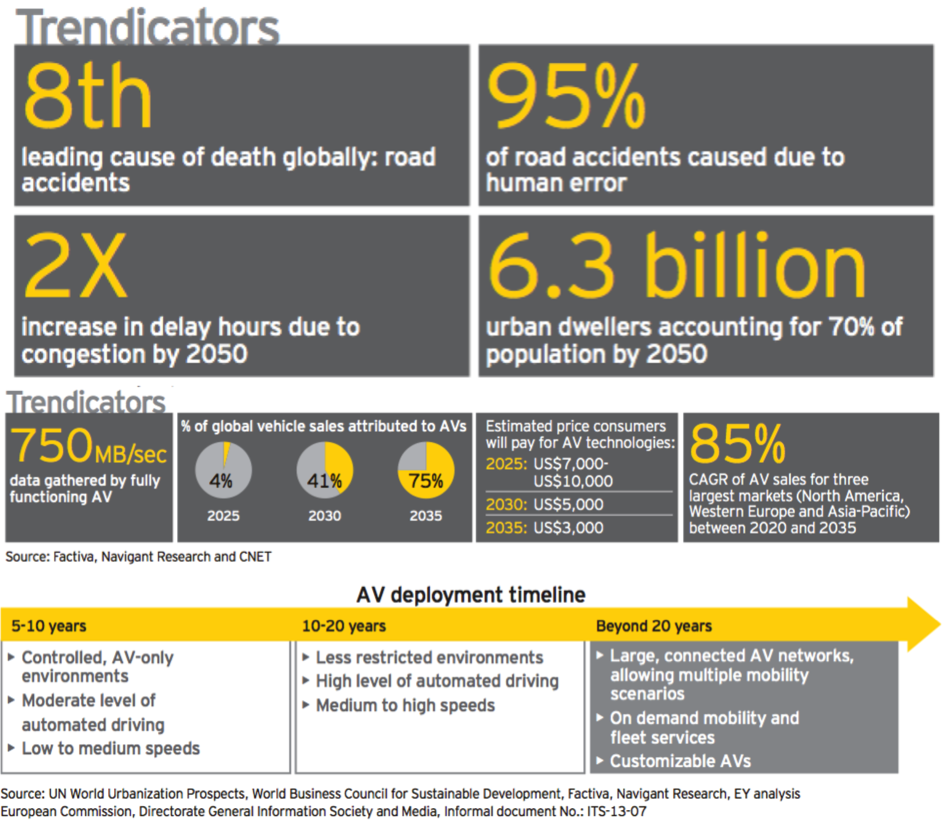Facts
The Autonomous Vehicle Institute exists to assist European communities, businesses, and government in navigating complex strategy and adoption issues that will accompany the evolution of connected and autonomous vehicles. Much of the content on this site has been collected from other sources, in which case the link and credit to the original source is provided.
Some key facts from Wikipedia on Autonomous Vehicles:
Definition:
Autonomous means having the power for self-government. Many historical projects related to vehicle autonomy have in fact only been automated (made to be automatic) due to a heavy reliance on artificial hints in their environment, such as magnetic strips. Autonomous control implies good performance under significant uncertainties in the environment for extended periods of time and the ability to compensate for system failures without external intervention. As can be seen from many projects mentioned, it is often suggested to extend the capabilities of an autonomous car by implementing communication networks both in the immediate vicinity (for collision avoidance) and far away (for congestion management). By bringing in these outside influences in the decision process, some would no longer regard the car’s behaviour or capabilities as autonomous; for example Wood et al. (2012) writes “This Article generally uses the term “autonomous,” instead of the term “automated.” We have chosen to use the term “autonomous” because it is the term that is currently in more widespread use (and thus is more familiar to the general public). However, the latter term is arguably more accurate. “Automated” connotes control or operation by a machine, while “autonomous” connotes acting alone or independently. Most of the vehicle concepts (that we are currently aware of) have a person in the driver’s seat, utilize a communication connection to the Cloud or other vehicles, and do not independently select either destinations or routes for reaching them. Thus, the term “automated” would more accurately describe these vehicle concepts”.
In the United States, the National Highway Traffic Safety Administration (NHTSA) has proposed a formal classification system:
- Level 0: The driver completely controls the vehicle at all times.
- Level 1: Individual vehicle controls are automated, such as electronic stability control or automatic braking.
- Level 2: At least two controls can be automated in unison, such as adaptive cruise control in combination with lane keeping.
- Level 3: The driver can fully cede control of all safety-critical functions in certain conditions. The car senses when conditions require the driver to retake control and provides a “sufficiently comfortable transition time” for the driver to do so.
- Level 4: The vehicle performs all safety-critical functions for the entire trip, with the driver not expected to control the vehicle at any time. As this vehicle would control all functions from start to stop, including all parking functions, it could include unoccupied cars.
An alternative classification system based on five different levels (ranging from driver assistance to fully automated systems) has been published by SAE, an automotive standardisation body.[11]
Predictions:
Autonomous vehicles are still a developing technology; a large number of companies and researchers have speculated about future developments and the possible effects of the cars.
- By 2016, Mercedes plans to introduce “Autobahn Pilot” aka Highway Pilot, the system allows hands-free highway driving with autonomous overtaking of other vehicles.
- By 2016, Mobileye expects to release hands-free driving technology for highways.
- By early 2017, the US Department of Transportation hopes to publish a rule mandating vehicle-to-vehicle (V2V) communication by an as-yet unspecified deadline.[90] GM says that by the 2017 model year, the Cadillac CTS will be V2V equipped.
- By 2018, Elon Musk expects Tesla Motors to have developed mature serial production version of fully self-driving cars, where the driver can fall asleep. However, he expects they would be allowed only some years after that, due to regulatory issues.
- By 2018, Mobileye expects autonomous capabilities for country roads and city traffic.
- By 2018, Nissan anticipates to have a feature that can allow the vehicle manoeuver its way on multi-lane highways.
- By 2020, Volvo envisages having cars in which passengers would be immune from injuries. Volvo also claims vehicles will effectively be “crash free.”
- By 2020, GM, Mercedes-Benz, Audi, Nissan, BMW, Renault, Tesla and Google all expect to sell vehicles that can drive themselves at least part of the time.
- 2020, ABI Research forecasts that truly self-driving cars would become a reality by 2020 and that 10 million such new cars would be rolling out on to United States’ public highways every year by 2032.
- By 2020, Google autonomous car project head’s goal to have all outstanding problems with the autonomous car be resolved.
- By 2024, Jaguar expects to release an autonomous car.
- By 2025, Daimler and Ford expect autonomous vehicles on the market. Ford predicts it will have the first mass-market autonomous vehicle, but released no target date for this.
- By 2025, most new GM vehicles will have automated driving functions as well as vehicle-to-vehicle communication technology.
- By 2035, IHS Automotive report says will be the year most self-driving vehicles will be operated completely independently from a human occupant’s control.
- By 2035, Navigant Research forecasts that autonomous vehicles will gradually gain traction in the market over the coming two decades and by 2035, sales of autonomous vehicles will reach 95.4 million annually, representing 75% of all light-duty vehicle sales.
- By 2040, expert members of the Institute of Electrical and Electronics Engineers (IEEE) have estimated that up to 75% of all vehicles will be autonomous.
- In 2014 Raj Rajkumar, director of autonomous driving research at Carnegie-Mellon University said that the artificial intelligence necessary for a driverless car would not be available “anytime soon” and that Detroit car makers believe “the prospect of a fully self-driving car arriving anytime soon is ‘pure science fiction.'”



